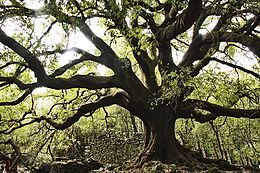
The Big Holm Oak of Mount Etna
This post is also available in:
 Italiano (Italian)
Italiano (Italian)
Quercus ilex, Fagaceae
The holm oak of Mount Etna is called “Ilici di Carrinu” and is the largest and oldest specimens of Quercus ilex in this area. It grows inside the Etna Park, in the Carrinu district, on the border between the territories of Milo and Zafferana Etnea, at 3.041 ft above sea level.
It is a majestic tree, over 700 years old, 65.6-ft high, with a 98.4-ft wide crown, and a circumference of about 16.4 ft. This majestic specimen grows in a forest of chestnuts, hazelnuts, ferns and brooms.
It has survived the frequent lava flows thanks to its elevated position, and it has been included in the list of the monumental trees of Italy; in 2019, it ranked among the four tree giants competing for the “Tree of the Year” official recognition, promoted by the Italian “Giant Trees Foundation”, which always takes part to the European “Tree of the Year” contest.
The other competing trees were the Oak of Fossalta (Quercus robur) in Portogruaro (in the province of Venice), the “Quercia delle Checche” (Quercus pubescens) in the Val d’Orcia (Tuscany), and the “Vallonea di Tricase” (Quercus ithaburensis subsp. Macrolepis) in Puglia.
This big holm oak grows in an area which until the Second World Was used by charcoal burners and by rye sowing farmers to make the traditional “irmanu” bread.
Today, it is still possible to find traces of the ancient tradition of coal production. Until 1800, this whole area was covered by the forest, rich in many other large holm oaks.
How to get there
Past Zafferana, take the road on the left, to Caselle. Reach the small square of Caselle and turn left. After some 500 yards, take the road on the left, to Ilice di Pantano. After another 109 yards, take the detour on the left, at the first bend. After 220 yards, park your car near a house with a green gate. Take the dirt road on the right side of the house and follow the mule track that runs alongside a chestnut wood, for about 650 yards. On the left, there is a clearing with a power trellis: at its foot, there’s a mountain path which leads to the terrace where the big holm oak grows.
Botanical Card
In Italy, this species is most widespread in the Ionian and Tyrrhenian regions, as well as on the major islands, while on the Adriatic side it is found quite sporadically.
There are two groups of relic trees belonging to warmer periods on the Euganean Hills and around the city of Ferrara.
The northernmost point of growth of the holm oak is in the Carnic Prealps, on vertical cliffs exposed to the south.
The holm oak is an evergreen plant with leathery leaves that form a dark green crown.
The species is xerotolerant, prefers protective shading in the juvenile phase and adapts well to different types of soils but avoids clayey-compact ones with any water stagnation.
The wood is hard and difficult to process and season as it tends to warp and split. It was once used to build tools or parts of farming wagons due to its extreme durability. It can be used as excellent fuel or very good coal.
This post is also available in:
 Italiano (Italian)
Italiano (Italian)
Contatti
Contrada di Carrinu - Zafferana Etnea (CT)(CT)
